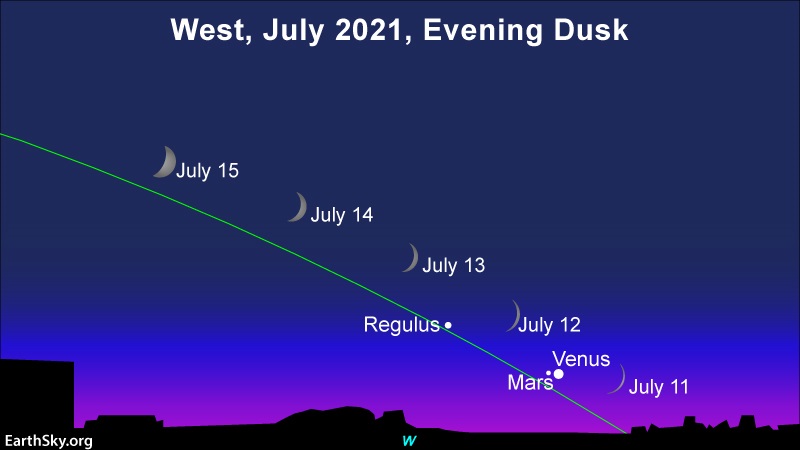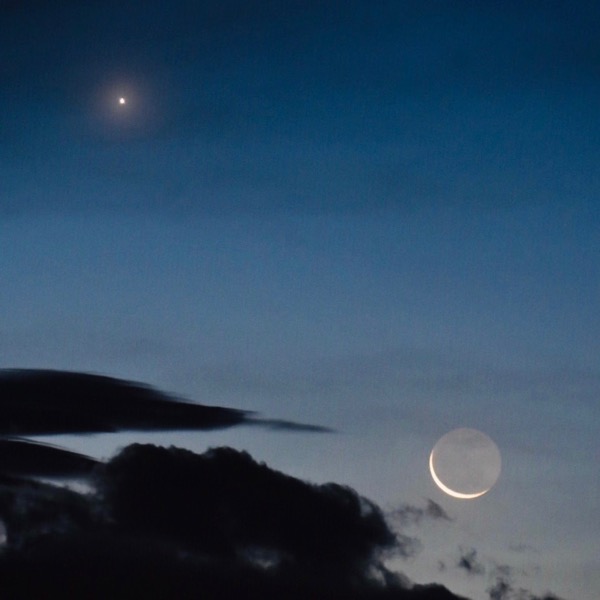
Venus and Mars conjunction July 12 and 13
Venus and Mars orbit the sun on either side of Earth. But, in the July evening sky, Venus outshines Mars by about 200 times. So you might look west after sunset now … and overlook Mars at first. Watch for Mars. It’s in conjunction with Venus this month. The exact time of the conjunction is July 13, 2021, at about 07:00 UTC. At that time, Venus will pass 1/2 degree north of Mars on our sky’s dome, or about one moon-diameter.
Do you have binoculars? Any ordinary binoculars will show Venus and Mars in the same field of view at their closest. Depending on where you live worldwide, Venus and Mars will be closest together in the evening sky on July 12 or July 13.
Wonderful luck for us all! The young moon will also be in view on these nights. You might catch the young moon’s return to the evening sky on July 11. Or you might have to wait until July 12 or 13 to see the young moon. When you do see the young moon, near blazing Venus with Mars snuggling close, you’ll be glad you looked.
Don’t miss the star Regulus
There’s a fourth object worth noting in the western twilight sky. After the moon goes by Venus and Mars, it’ll also go by Regulus, the constellation Leo’s one and only 1st-magnitude star, about a day later. Pay attention to this “fixed” star of the zodiac throughout the rest of July 2021, to note the changing positions of Venus and Mars.
At the time of the Venus and Mars conjunction, both planets are both heading for Regulus. Venus will have a conjunction with Regulus on July 21, 2021, passing 1.2 degrees north of this star. Then, on July 29, 2021, Mars will rendezvous with Regulus, sweeping 0.7 degrees north of Leo’s brightest star.
When will you catch the young moon?
To see the very young moon on July 11 and 12, you’ll need an unobstructed horizon in the direction of sunset. If the whisker-thin crescent eludes your detection on July 11, just try again on July 12.
Day by day, a wider yet still slender waxing crescent will appear higher up at sunset and will stay out later after dark. On July 13, 14 and 15, 2021, the illuminated side of the moon serves as your arrow in the sky, pointing downward to the star Regulus and the planet Venus. Regulus, though a respectably bright star, pales in contrast to Venus, with Venus shining more than 100 times brighter than Regulus.
From most places worldwide – given clear skies and an unobstructed horizon – you should have a good chance of seeing both the very young moon and Venus some 45 minutes (or less) after sunset on July 11. After all, the moon and Venus rank as the second-brightest and third-brightest celestial bodies to light up the sky, respectively, after the sun.
Just don’t delay after the sun goes down! Venus and Mars will follow the sun beneath the horizon before nightfall at mid-northern latitudes and far-northern latitudes. In contrast, as seen from the Southern Hemisphere, Venus and Mars will set after nightfall.
Wherever you are, make it a family affair and bring along the kids. Their young eyes may catch the young moon and Venus popping out at evening dusk before yours do.

When is nightfall?
We give the approximate time of nightfall (end of evening twilight), and Venus’ setting time at various latitudes (presuming an absolutely level horizon):
40 degrees north latitude
Venus sets: 1 hour and 35 minutes after sunset
Nightfall: 2 hours after sunsetEquator (0 degrees latitude)
Nightfall: 1 hour and 15 minutes after sunset
Venus sets: nearly 2 hours after sunset35 degrees south latitude
Nightfall: 1 hour and 30 minutes after sunset
Venus sets: 2 hours and 10 minutes after sunset
Find out Venus’ specific setting time in your sky at Old Farmer’s Almanac or timeanddate.com.
We should mention that the setting time of the moon is variable, depending upon longitude as well. Find out the specific moonset time in your sky via timeanddate.com.
We did not mention Mars’ setting time because Mars and Venus set at nearly the same time for the next several days.

What is earthshine?
Also note – with the eye alone or an optical aid – the soft glow of earthshine adorning the dark or nighttime side of the moon. Earthshine is twice-reflected sunlight, with the Earth reflecting sunlight to the moon, and the moon, in turn, reflecting sunlight back to Earth.
The lunar terminator – the line dividing the lunar day from the lunar night – shows you where it’s sunrise on the young, waxing crescent moon.
Bottom line: Venus and Mars will be closest together in the evening sky on July 12 or July 13. The young moon will join them for several evenings in the western twilight sky.











